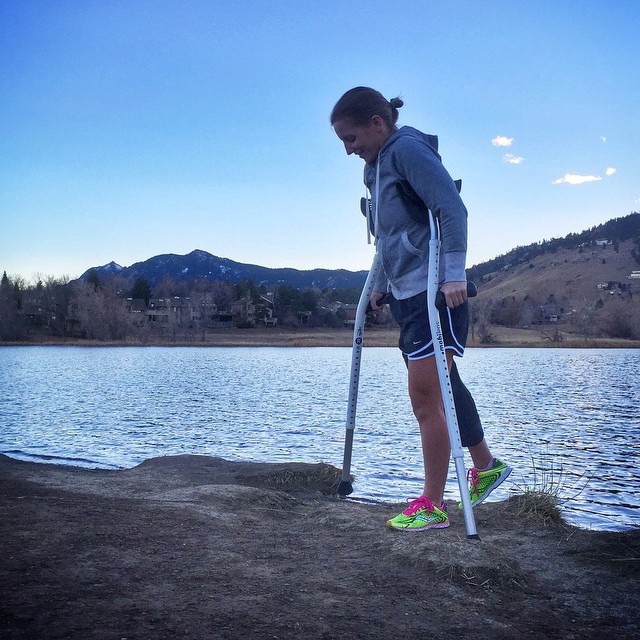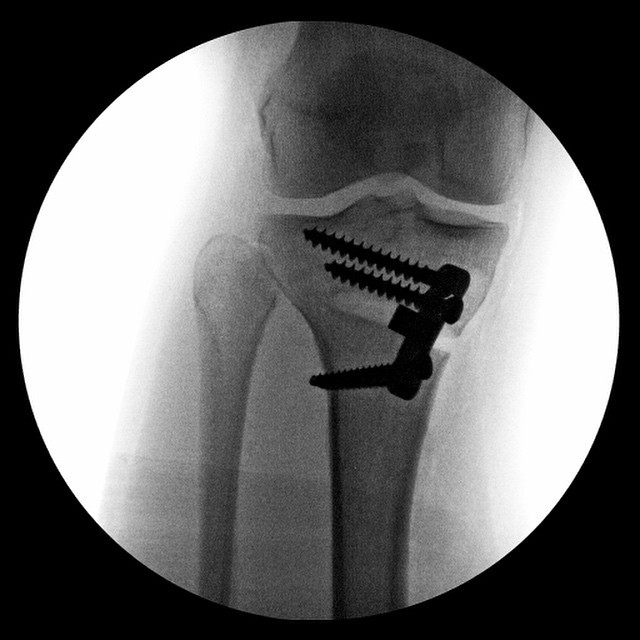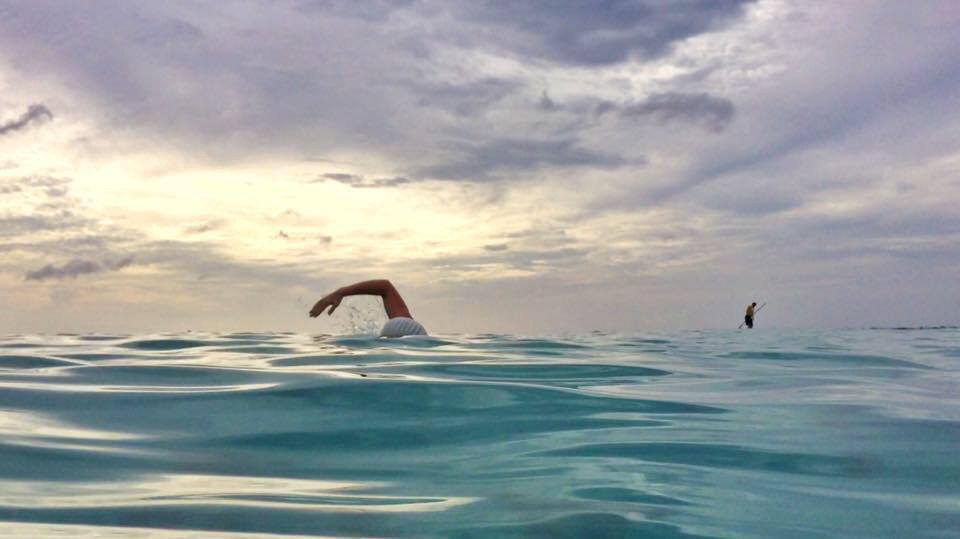Being injured, still.
I have spent six months of the last year on crutches. For someone who loves to run, six months is a long time to be unable to walk. Long enough to make me wonder, am I even an athlete anymore?

After the crash in April last year, I progressed reasonably well with my rehab work, and was back swimming and then biking. I even did an open water 5km swim race, before I was able to walk. I did months of functional strength work, then was able to skip, in preparation to start running. After about seven months, I progressed to running for three minutes, then walking a few, which felt joyful, yet painful. On New Year’s Eve, in a vain attempt to beat 2014 with a substantial milestone in my recovery, I ran for a whole ten minutes. The pain for reaching those double digits was a reminder of just how far from normal I still was, some eight months after the accident.
When you’re injured for a long time, people may offer different advice, even the sports professionals. You should do more strength work. Do more volume. Take more rest. Be more patient. I went to a world-renowned orthopaedic clinic for a definitive path forward. After hours of tests and examinations, the surgeon explained that the damage around my knee meant bone was striking bone, which he said must feel like a red hot poker. It was a huge relief to hear that there was a serious problem; that I wasn’t insane. Then the surgeon broke the staggering news: “We need to break your leg again.”
Prospects didn’t sound great, but he said without this surgery I simply would never run again. I didn’t hear much after that. Thankfully Andy, my wonderful boyfriend, listened to everything, and later reassured me that I was in the best hands, and that yes it was frightening, but we’d get through this.

The very next day, they performed an osteotomy and microfracture on the tibia; realigning the bone to take pressure off the damaged cartilage. Alas, cartilage cannot be repaired - once it’s gone, it’s gone forever. I now have arthritis, for which there is no cure, but that’s not my concern, for now. For now, I want to know if I can run again. Actually, for now, I’d like to be able to walk pain free. It’s been six months since surgery, and every step I take is uncomfortable. Incidentally, “uncomfortable” is a good word to use to when you don’t want to hear “painful”.
I’ve heard some professional athletes talk about injury as a mental challenge, a temporary setback. But what if it’s not? What do you do if the setback is permanent? I have permanent scars on my face and body, which is annoying but tolerable. But what if I’m never pain free? What if the damage to my knee means I can never run again? What if I can’t be an athlete? Early on, I closed my mind to these thoughts. Recently I’ve started confronting thoughts about the worst case scenarios: that I won’t be able to run ever again, that I’d have to find another sport. It’s been slightly freeing to face these thoughts, to realize I don’t have much control over what ultimately happens. But until I’ve heard, or felt, a definitive “No”, I’ll get back to work influencing that outcome as best I can.
I have learned that it’s useful to be a little pessimistic. When I was first told I had a broken leg, in the initial shock, I didn’t grasp the severity. I thought I’d just have to be patient for that twelve weeks, then I’d be able to hop back to it. This year, facing surgery, and a freshly broken leg, I knew something of the difficulty ahead. I knew that when your leg hasn’t bore any weight for three months, the muscles waste away, the nerves and tendons in the foot aren’t familiar with contact on the ground, the whole leg forgets how to move, how one goes through the motion of walking. Even your arms, having been glued to the handles of crutches, forget they too are meant to move when you walk. I knew recovery may not follow a linear progression. It can be demoralizing, it is uncomfortable, and it is slow.
There are frequent challenges to embracing this insecurity. How much can I push myself? How much is too much? How much am I prepared to pay later, if I do more now? How much should I be confident, and how much should I doubt?
Being injured for a prolonged period is tough. Energy levels drop, and my appetite has dropped to the minimum required to function. Those quads I’d lovingly built up, look like a half burst balloon. Fitness has no loyalty. Not being able to really exert yourself physically takes a toll mentally as well. Exercises can still be hard to do - it took over ten weeks of work to be able to fully bend and straighten my knee. But you can’t enjoy the freedom of a long run, or experience that blissful, total exhaustion after a hard bike. There are no highs or lows, you just do the work.
As an endurance athlete, I’d become good at tolerating pain. But I’d made that pain, in pursuit of my work to become stronger, fitter, faster. I could turn it down, when I felt weak, or up, as I developed as an athlete. Overcoming that pain brings a huge sense of accomplishment, a feeling of really being alive. The crash brought pain through trauma, and the surgery brought pain that someone else, or drugs, could control. Piercing pain that made any other thought or movement impossible. Dull pain, so ever present that it’s now seen as acceptable, the new normal.
A friend once introduced me to some professional triathletes as, “Keavy is like a pro, just slower”. Being a triathlete is not my job, I’m not even fast, strong or successful at it. But it has brought me great friends, experiences and joy; it’s helped shape how I think of myself. I miss there being athletic seasons to my year. I miss planning out what races I can do, where I want to travel to, who else is doing what, if I have an excuse to buy new kit yet. I miss racing. I miss having a special day to perform, to collapse, and to enjoy that sweet “I did that” aftertaste.
All this loss, prompts the questions: if I can’t do one, sometimes two, thirds of my chosen sport, if I can’t race, am I still an athlete? Who am I, if not an athlete? At its core, I think being an athlete is about commitment to pursuing what your body and mind are capable of. I tell myself that then, that I’m still doing that. Trying to build back range of motion, to re-engage muscles, to fire muscles in a pattern as they re-learn movement, to build strength… tending to my recovery is part of my training. If I do these things in multiple sessions throughout the day, it can even feel like a training schedule. A rhythm helps you keep going.
I feel grateful to be otherwise physically and mentally sound from the accident. I also feel the loss of not doing the activities, the durations, and the intensities, that I want. I feel sad to not be able to race, and frustrated to not even know when I might be able to race again. I’m tired of the continual low level pain, and the one step forward, two steps back. But if I can still seek ways to pursue the core goals, to exert myself within my individual limits, then I can maintain the identity of an athlete, that sense of self. I can build on that, I am an endurance athlete after all.
